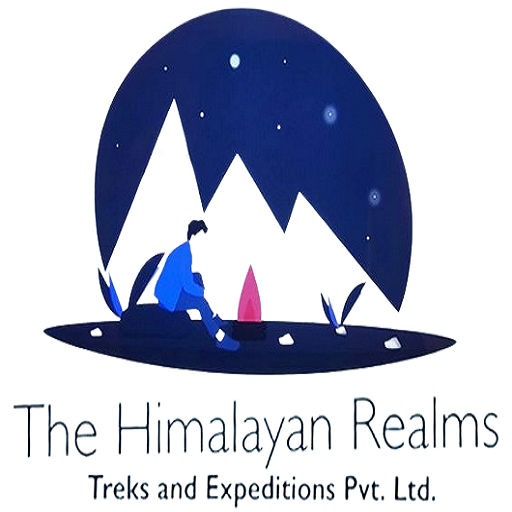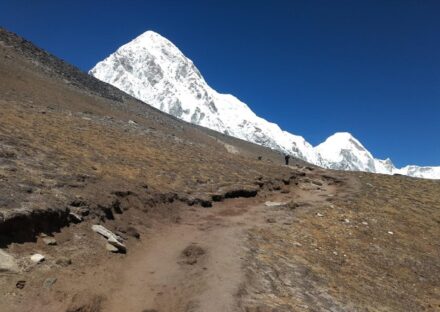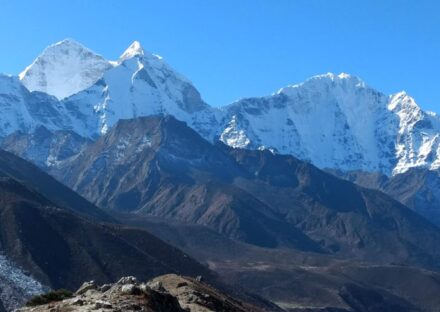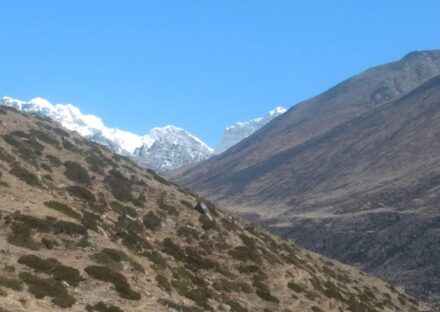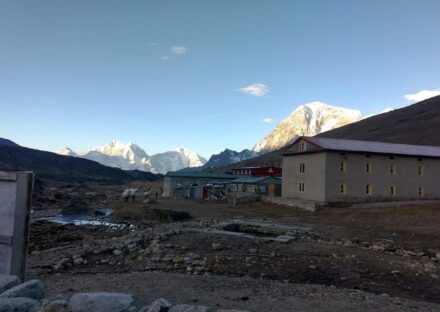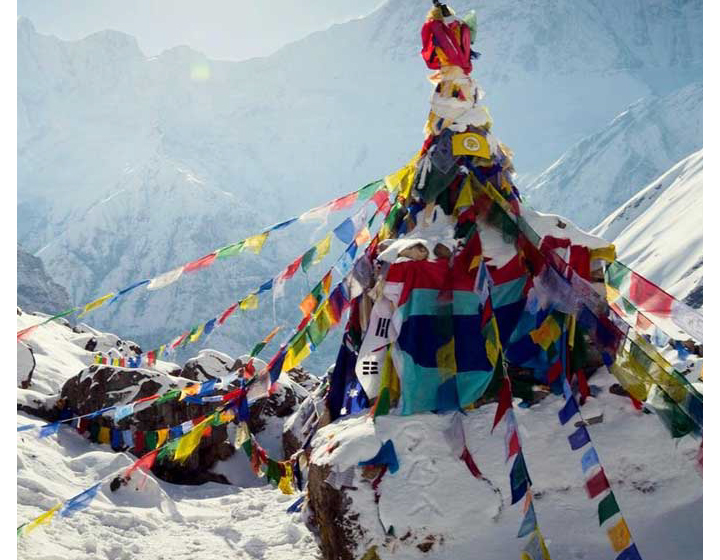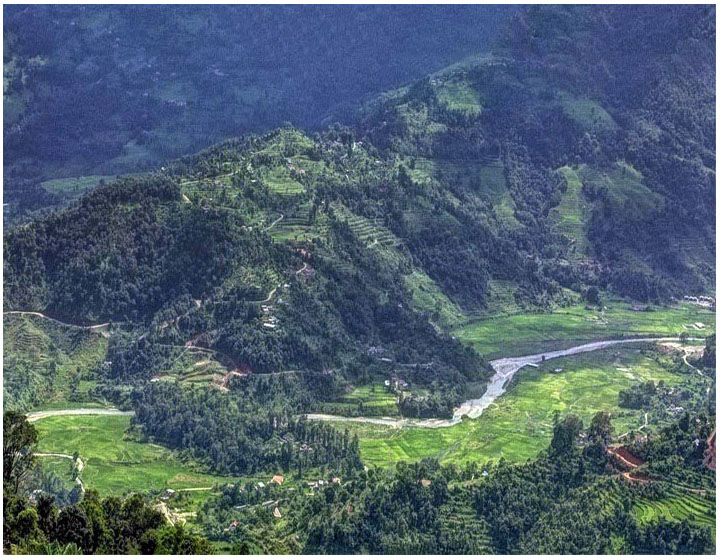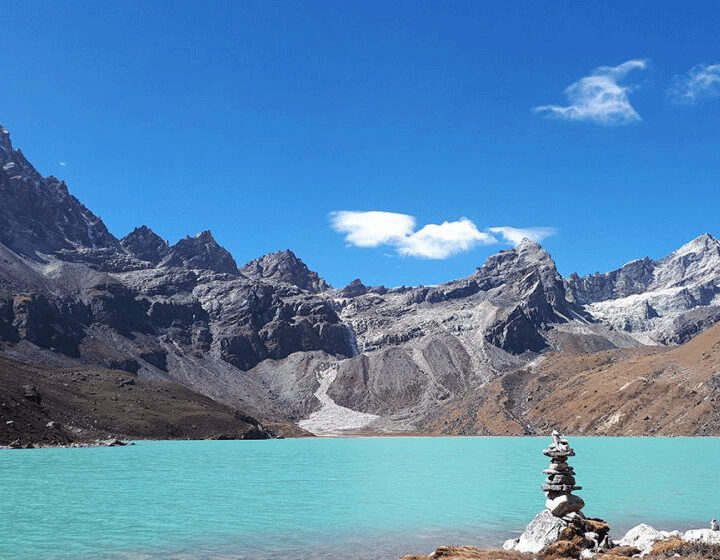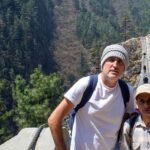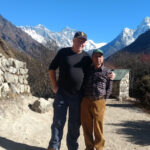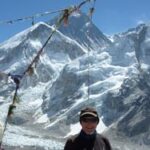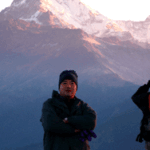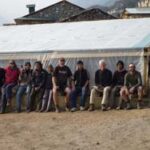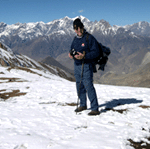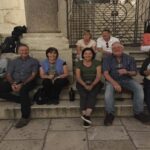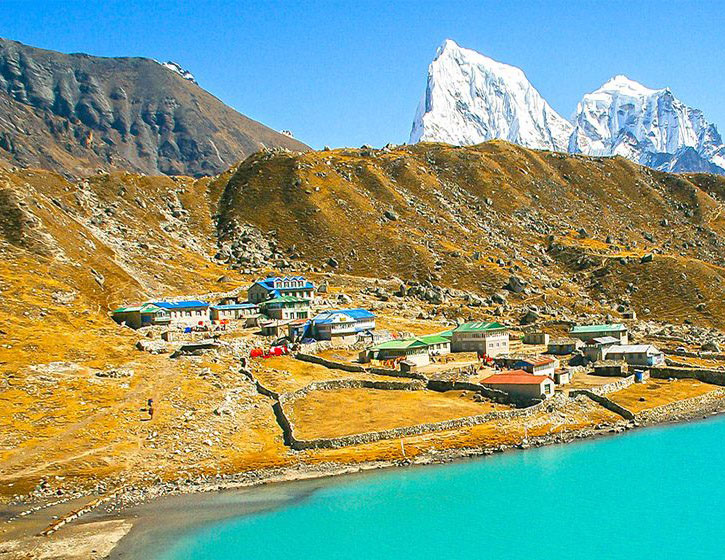
Trip overview
Gokyo Lake Trek: A Comprehensive Overview
The Gokyo Lake trek is a spectacular alternative to the famous Everest Base Camp climb, with breathtaking vistas of the world’s highest peaks, turquoise glacial lakes, and the majestic Ngozumpa Glacier—the Himalayas’ largest glacier. This trek, which takes place in Sagarmatha National Park, offers a calmer and less congested path, making it suitable for travelers looking for a blend of nature, culture, and high-altitude beauty.
Introduction to the Gokyo Lake Trek.
The walk to Gokyo Lakes takes you deep into the heart of the Khumbu region, where you’ll find six magnificent glacier lakes at elevations ranging from 4,700 to 5,000 meters. The trek begins by following the serene banks of the Dudh Koshi River, gradually leading through traditional Sherpa communities. Along the way, travelers will pass by historic monasteries that echo centuries of culture and spirituality. Furthermore, the journey is adorned with beautiful trees and lush landscapes, creating a picturesque trail. Eventually, after soaking in the rich heritage and natural beauty, trekkers arrive at the breathtaking Gokyo Valley, where stunning glacial lakes and towering peaks await.. A notable highlight is the ascent to Gokyo Ri (5,357m), which provides a panoramic picture of Everest (8,848m), Lhotse (8,516m), Makalu (8,485m), and Cho Oyu (8,188m).
Lifestyle of People
The Sherpa people, who are well-known for their hospitality and mountaineering abilities, live largely in the region.
Agriculture and trade include growing potatoes, barley, and vegetables in the summer, as well as herding yaks for dairy products.
>Mountaineering and tourism: Many Sherpa’s serve as guides and porters on trekking and climbing adventures.
>Buddhism and Spirituality: Tibetan Buddhism has a profound impact on daily life, with monasteries playing an important role.
>Sherpa settlements along the trail, such as Namche Bazaar, Dole, Machhermo, and Gokyo, vividly demonstrate a modest yet tenacious way of life. These villages, deeply rooted in tradition, have adapted remarkably to the severe, high-altitude environment. As trekkers ascend through the region, they witness how the Sherpa people skillfully balance resilience and hospitality, overcoming harsh conditions while preserving their cultural heritage.
Religious and cultural aspects.
Tibetan Buddhism rules the Gokyo region, with gorgeous monasteries, prayer flags, and Mani walls bordering the trekking trails.
The iconic Tengboche Monastery, the largest in the Everest region, serves as a spiritual nexus for both trekkers and locals.
The Gokyo Lakes are revered by both Hindus and Buddhists. Hindu pilgrims think the lakes are the home of Nag Devata (the Serpent God), whilst Buddhists identify them with Guru Rinpoche (Padmasambhava).
The Janai Purnima event involves Hindu devotees performing rituals and taking holy dips in lakes.
Vegetation and Natural Beauty.
The Gokyo walk passes across a variety of environments, from lush lowland woods to bleak alpine peaks.
>Lower elevations (2,500m to 3,500m): Rhododendron, pine, and birch The forests are home to Himalayan Monals (Nepal’s national bird) and musk deer.
In the middle elevations (3,500m – 4,500m), juniper bushes and dwarf rhododendrons have replaced the thick woods.
High Altitude (4,500m+): Rugged glacial terrain with limited vegetation, where hardy plants such as moss and lichens thrive.
Atmosphere and Climate.
Spring (March-May) is ideal for hiking, with sunny skies, blossoming rhododendrons, and mild temps.
Autumn (September–November) is another wonderful season, with crisp mountain views and dependable weather.
Winter (December-February) is harsh and cold, with heavy snow making the journey difficult.
Monsoon season (June-August): Trails become slippery and less visible, but the Gokyo region receives less rainfall than lower locations.
Because of the high altitude, nights are always frigid, but days can be warm in bright weather.
Side Trips and Extensions
Gokyo Ri (5,357 meters): A must-do for The forests are home to Himalayan Monals (Nepal’s national bird) and musk deer.
In the middle elevations (3,500m – 4,500m), juniper bushes and dwarf rhododendrons have replaced the thick woods.
High Altitude (4,500m+): Rugged glacial terrain with limited vegetation, where hardy plants such as moss and lichens thrive.
Short Itinerary
Day 1: Arrival in Kathmandu
Day 2: Flight to Lukla (2,860m)
Day 3: Trek to Namche Bazaar (3,440m) – 5-6 hrs
Day 4: Acclimatization d
Day 5: Trek to Dole (4,200m)
Day 6: Trek to Machhermo (4,470m) – 4-5 hrs
Day 7: Trek to Gokyo (4,790m) – 4-5 hrs
Day 8: Hike to Gokyo Ri (5,357m)
Day 9: Trek back to Dole
Day 10: Trek to Namche Bazaar
Day 11: Trek to Lukla (2,860m) Day 12: Fly back to Kathmandu
Day 13: Buffer day
Day 14: Departure
Itinerary
When you arrive at Kathmandu Tribhuvan International Airport, our representative will pick you up and take you to your reserved hotel. After check-in at the hotel, you will be briefed about your trekking tour program. After the briefing session, you can relax and unwind at the hotel. If you want to get familiar with this place, you can go for a walk in the Thamel area in the evening. Meals included: none
We embark on a journey with an experienced tour guide to the historical and spiritual attractions of Kathmandu, which is also a UNESCO World Heritage Site. You will visit the historic Kathmandu Durbar Square, the sacred Hindu Temple of Pashupatinath, the famous Monkey Temple (Swayambhunath) and the Buddhist Temple (Boudhanath), one of the largest stupas in the world. In the afternoon, our leader checks our equipment, introduces us to the other participants, and we talk about their trip. Meals included: Breakfast
You will escort to Tribhuvan domestic airport in a private vehicle to board a flight to Lukla. After a 35-40 minute flight, you will land at Lukla airport. Upon arrival at Lukla airport, you will be introduced to the other crew members who are waiting for your arrival. At the same time, the luggage is prepared for your porter. As soon as everything is ready, you will start the trek towards the destination of the day, leaving Lukla behind. After four hours of downhill and flat trail experience, you will reach phakding. After a short rest, you may like to take a walk through the village of Phakding or even a walk to the nearby gompas to acclimatize. The night is spent at the lodge in Phakding. Meals included: Breakfast, lunch, and dinner
Today is the second day of your trek, and our destination is the Namche Bazaar. Without wasting time, we leave Phakding and walk towards Monju over some suspension bridges and small settlements. Monju is popularly recognized as the gateway to Sagarmatha National Park. Upon arrival in Sagarmatha National Park, the team leaders at the entrance will take care of the necessary documents for the National Park. We then enter the national park, after a short vertical descent taking us over some suspension bridges, the path then climbs taking you over the "Hillary Suspension bridge where you continue to climb into Namche Bazaar, which offers the first view of Mount Everest along with other peaks. You will spend a night at a Lodge in Namche Bazaar. Meals included: Breakfast lunch and dinner
Acclimatization is essential so that we can adapt to the gradual changes in the environment. It will also help us avoid acute mountain sickness. Today we take part in activities that help us adapt to the change in altitude and the drop in the air. Staying active is the best way to acclimatise, instead of resting we visit the Sherpa Museum and the famous statue of Tenzing Norgay here you will find genuinely epic views of Everest, Lhotse, and Ama Dablam. After a short stay we climb to the "Everest View Hotel' at 3,880 meters above sea level where we have lunch. Then we return to the Namche Bazaar to explore the rest of the day before sleeping. Meals included: Breakfast lunch and dinner
The fourth day of the trek, and our goal is to reach Dhole. If you leave the Namche Bazaar behind, you can easily walk to Kyangjuma, from where you have one of the best views of towering peaks. The walk continues via the rhododendron forest to Sanasa, an significant crossroads of trails in the Everest Base camp and Gokyo Valley. We leave the Everest Base Camp Trail, follow the stone step path on our left, and head towards Mong. From Mong, there is an easy descent to the banks of the Dudh Koshi River when we cross Phortse Thanga. We walk to Tenga and follow the banks of the Dudh Koshi River. From here, we leave the river bank and go through the birch and rhododendron forest to Dhole. The night is spent in a hostel in Dhole.
Meals included: Breakfast lunch and dinner
After having breakfast at the dole, we start trek to Machheromo. On the way, you walk with the pine and oak forests. You will go uphill gently so that it is not as difficult as the day before. Along the way, you can see peaks such as Taboche, Cholatse, Cho Oyu, and Everest. Meals included: breakfast lunch dinner
We climb a hill and enjoy the view of the Dudh Koshi valley and the Mount Kangtega, Thamserku, and Cho-Oyu. Beyond the ridge, the valley widens when the path leads through a choir and reaches Phangga. You go down to the river bank before walking the end moraine of the Ngozamba glacier. We passed Longpongo, Raboche Tsho, and Dudh Pokhari before we reached Gokyo. On the way next to the first lake, we see the footprints of a Lama (Buddhist priest). We explored Dudh Pokhari before saying good night. Night stay at Lodge in Gokyo. Meals included: Breakfast, lunch, and dinner
We spend another day in Gokyo to get used to the altitude. In good weather, we walk to Gokyo Ri today. From the top of Gokyo Ri, we admire the view of the Himalayas and the calm lakes of Gokyo. We also hiked to the fourth and fifth lakes of Gokyo. The fourth lake is only 3 km north of Gokyo. It is Specified by high cliffs and Himalayan peaks that rise above it. We continue and reach the fifth lake. Climbing a nearby hill guarantees you incredible views of mount Cho-Oyu, Everest, Lhotse, Gyachung Kang, Nuptse, and Makulu. From here, we can see a lot more: The place is called Scoundrel's POV. From the northern part of the fifth lake, we see the Cho Oyu base camp and the Ngazumpa glacier, the largest glacier in the world. We go back to Gokyo for the night stay.
Meals included: Breakfast, lunch, and dinner
We descend a path along the Dudh Koshi River and pass the first Gokyo Lakes. On the way, enjoy the view of the Cholatse and Taboche peaks. Our route descends before we climb a hill. After reaching the Chorten on edge, we see a great view of the mount Thamserku, Cho Oyu, and Kangtega. You walk through the villages of Machhermo, Luza, and Lhafarma before reaching Dole. We will spend the night in Dole.
Meals included: Breakfast, lunch, and dinner
Today, you'll go down a steep path to Phortse Thanga and think a lot of rhododendrons, waterfalls, and wildflowers. You also find wild goats, musk deer, pheasants, etc. From Mong, you can enjoy a good view of Khumbila Peak. On the way to Namche, you will admire the views of the Taboche, Ama Dablam, Thamserku, and Kangtega mountains. After walking for a while, we reached an intersection where the path from Sanasa meets our way. We hiked a trail that hangs on a wooded hill beyond Kyangjuma and crosses several curves and reaches to Namche Bazar. You will stay at standard lodge in the Namche Bazaar.
Meals included: Breakfast Lunch and dinner
We descend a rocky path and cross several suspension bridges before walking on a flat road. The air is warmer than we go the same way to reach Lukla. Our hike on the mountain ends after reaching Lukla. We spend our time remembering our time on the hill. Night stay in Lukla. Meals included: Breakfast, lunch, and dinner
Today is your last day in the Everest region of Nepal. Your porters bring your luggage to the airport, where we say goodbye. As soon as the plane has landed at the Lukla airport, we board the plane and fly back to Kathmandu in the early morning, enjoying the panoramic view from the sky again. Our office vehicle will be waiting for you at Kathmandu Airport that will accompany you safely to the three-star hotels in Kathmandu. Meals included: Breakfast
It is the last day of your trip to Nepal. If your flight is scheduled early in the morning, a representative of our company will accompany you according to the departure time of your flight from the airport. However, if the flight is scheduled later in the evening, you can go shopping and pick up some souvenirs or stroll around the shopping areas of Kathmandu. However, if you wish to spend an extra day in Nepal, we can also arrange other adventure activities that you can participate in during your stay in Nepal.
Included
- All airport, hotel airport transfers.
- 2-night hotel in Kathmandu
- National Park permit & Pasang Lhambu village entry permit.
- Flight fare from Kathmandu-Lukla-Kathmandu.
- Accommodation in the tea house,
- Food, Tea/coffee during trek.
- Guide: – including salary, insurance, equipment, flight, food and lodging.
- Porter: – including salary, insurance, equipment, food and lodging.
- For guest: -Down jacket, Good sleeping bag (down jacket and sleeping bag are to be returned after trip completion).
- Transfer from airport to hotel in Kathmandu
- All government and local taxes.
- Final departure from hotel to international airport transfer.
Not Included
- Food in Kathmandu ( Lunch & Dinner). Kathmanmdu.
- Bakery food during the trek.
- Nepal Visa fee.
- International airfare.
- Extra night accommodation in Kathmandu.
- Travel and rescue insurance if guest get mountain sickness and need to rescue helicopter.
- Personal expenses example (phone calls, laundry service , bar bills, battery recharge, WIFI charge, extra porters, bottle water or boiled water, shower etc.)
- Tips for guide and porters
Useful Info
The Gokyo Lake Trek is one of the most scenic treks in the Everest region, offering breathtaking views of turquoise lakes, glaciers, and snow-capped peaks, including Mt. Everest (8,848m), Cho Oyu (8,188m), Lhotse (8,516m), and Makalu (8,485m).
Trek Overview
Duration: 14 Days
Max Elevation: 5,357m (Gokyo Ri)
Trek Difficulty: Moderate to Strenuous.
Best Seasons: Spring (March–May) & Autumn (Sept–Nov)
Accommodation: Teahouses & Lodges
Permits Required:
Sagarmatha National Park Entry Permit
Khumbu Pasang Lhamu Rural Municipality Permit
Packing List Essentials
Clothing: Layered trekking gear, insulated jacket, thermal wear, gloves, hat.
Footwear: Good quality trekking boots with ankle support.
Gear: Sleeping bag (-15°C rating), trekking poles, sunglasses, headlamp.
Snacks: Energy bars, dried fruits, and nuts.
Health: Diamox (for altitude sickness), first-aid kit, personal medications.
Best season for Gokyo lake trek
Spring (March–May)
Mild temperatures and stable weather
Blooming rhododendrons and lush greenery
Clear mountain views, though occasional haze in lower elevations
Autumn (September–November)
Stable weather with clear bluskies
Crisp mountain views after the monsoon season
Ideal trekking conditions with moderate temperatures
